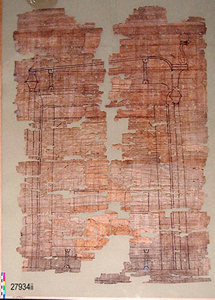
Notes on the construction of formal compositions with guidelines
and grids
1. Old Kingdom (about 2686-2181 BC) Guidelines (Robins 1997: 76-8)
In the Old Kingdom there is no evidence that artists drew a grid of squares to prepare their compositions, in the manner of later periods. However, guidelines do appear on some late Old Kingdom sequences of figures, to keep them in proportion to one another.
Armpits
Junction of neck and shoulders
Hairline
Top of head
Not all lines are present on all figures, and the hairline is more commonly marked than top of head.
During the Sixth Dynasty an eighth line was introduced halfway between soles and kneeline.
Guidelines were part of initial draft, not seen in the final version, so they survive in unfinished scenes. One function was to help align rows of figures.
They assisted execution of a composition, but did not stifle stylistic change. For example, the human figure proportions change between Fifth-early Sixth and late Sixth Dynasties, with shift to narrower shoulders, and raising of small of back to around the elbow line. The eyes also undergo enlargement to occupy greater area of the face than before. The later Sixth Dynasty proportions are sometimes now known as the Second Style, from the research by E Russmann
2. Squared grids in the Twelfth Dynasty (Robins 1997: 106-9)
Evidence for grids in unfinished scenes from Thebes and Abydos appears not in the Eleventh but in the Twelfth Dynasty: perhaps they represent an innovation associated with the reorganisation of Egypt at the foundation of the new Residence at Itjtawy at the beginning of the Twelfth Dynasty.
At this time the proportions return to those of the Fifth-early Sixth Dynasty.
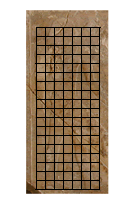 |
figure of Mentuhotep in hypothetical grid (click on the image for a larger picture) |
The grid allowed the other points of the body to be aligned:
Seated figures occupied 14 squares between soles and hairline:
Grids were usually laid out in red paint and were often uneven, clearly a guide for drawing acceptably proportioned figures, not a mathematical straightjacket. They were not followed slavishly; on the same monument adjacent figures can have slightly different proportions.
3. The grid in the New Kingdom (Robins 1997 : 141-2, 151, 168, 172, 191-2)
Theban tomb-chapels have grids for the largest figure in a scene, with smaller figures drawn freehand or in grids of smaller squares; from about the reign of Amenhotep II, grids were not applied to every wall, but only to major figures (usually tomb-owner and wife), and other figures were drawn freehand or with guidelines. This is the origin of the freer, fluid style of Theban tomb-painting in the second half of the 18th Dynasty.
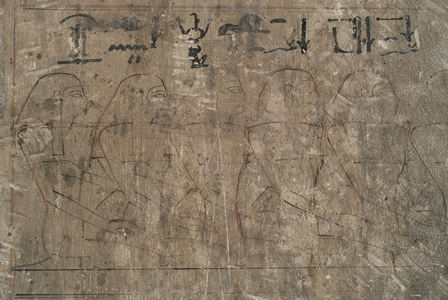 |
(click here for a drawing of this stela) |
In the Amarna Period, an extra two squares were added; enough traces of grids survive to show that one was added between neck-and-shoulders and hairline, to accommodate the longer neck and face, the other for the pendulous stomach. The knee line still fell at square 6, but in the old system this was one third, whereas in the new it was 6/20, and this gives the Amarna figures their short lower legs.
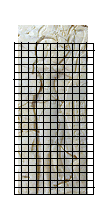 |
figure of Nefertiti in hypothetical grid (click on the image for a larger picture) |
In the more extreme early Amarna style the figures have long faces and necks, narrow shoulders, short upper torsos, large thighs and spindly limbs.
After the Amarna Period, in the Valley of the Kings guidelines were used in the unfinished part of Horemheb’s tomb, and the figures still have the short leg of Amarna art. In the unfinished part of the tomb of Sety I, there is no evidence for grids; on the pillars there are guidelines for the hieroglyphs, but the large figures have been drawn freehand, first in red, then overdrawn and edited in black. It seems from this and the later tombs, as well as the figured ostraca, that the Deir el-Medina crews did not use the grid. By contrast, there are grids in the temple of Sety I at Abydos, with, in the unfinished (painted only) section, a grid for each scene for the major figure, and smaller figures drawn in freehand.
4. Grids in the Late Period (Robins 1997: 212, 237, 246)
Reform during the Twenty-Fifth Dynasty: reduction in size of squares, with 5 old squares converted to 6 squares in the new grids. There were now 21 squares from soles to upper eyelids instead of 18 squares for standing figures from soles to hairline (hairline comes at 21.6 so no longer on a grid line).
Possibly the reform enabled a correspondence with the Egyptian units of measurement. The small cubit measures about 45 cm, comprising six palms; the forearm (about 45 cm on a man of average stature) occupies six squares in the new grid, so the reform produces a rough alignment of one square to one palm whether intentionally or not.
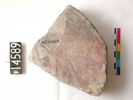 |
Note the gridding of ancient monuments: this can be shown to be later, not part of a draft as an original grid, because the lines run over the earlier paint and finished relief. Many of these surcharge grids have a random number of squares, not related to the attested grid systems. However, two of the Third Dynasty panels beneath the Step Pyramid of Netjerkhet (Djoser) have grids conforming to the later system.
Grids were still being used in the Ptolemaic Period, e.g. chapel of Ptolemy I from Tuna, and stela of Tentimhotep from Saqqara, year 10 of Cleopatra VII.
Gridded squares - UC 72528 has the name Amenmose on it and belongs therefore most likely to the New Kingdom (about 1550-1069 BC) - the others are less easy to date, probably Late Period.
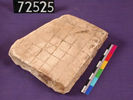 |
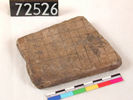 |
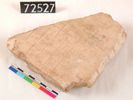 |
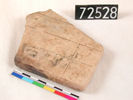 |
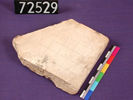 |
Copyright © 2000 University College London. All rights reserved.